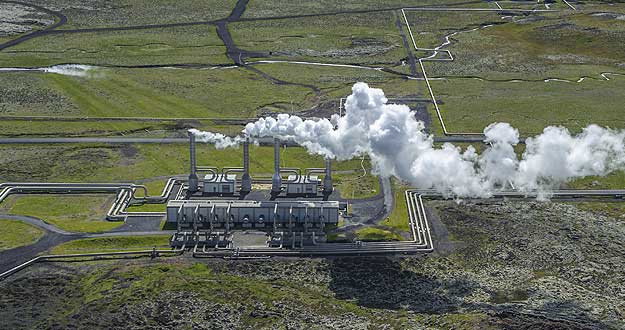A study by the University of Valladolid (Northwestern Madrid, Spain) said that geothermal energy can quintuple the current energy.
Researchers at the University of Valladolid have estimated how much electricity could be obtained with the heat stored underground, the first ten miles of the mainland. The results indicate that about 700 gigawatts, which is five times the entire installed capacity today. Galicia, Castilla y Leon, Andalusia and Catalonia are the regions with the greatest potential.
The temperature increases by 30 ° C per kilometer descended underground. This thermal gradient generated by the flow of heat from inside the Earth and the decay of radioactive elements in the crust, produces geothermal energy. About 500 plants around the world and used to generate electricity, but in Spain there is still none.
However, the basement of the Iberian Peninsula has capacity to produce up to 700 gigawatts, if this resource with stimulated geothermal systems were exploited (EGS, for its acronym in English) between 3 and 10 km depth, where temperatures exceed 150 ° C . This is confirmed by a study that engineers at the University of Valladolid (Grape) published in the journal Renewable Energy.
"Then, the heated fluid is brought up to the geothermal power plant, where electricity is produced, generally by a binary cycle (heat exchange among water and an organic liquid), and it is re-injected into the reservoir in a closed loop" .
Although there are EGS experimental stations in countries like USA., Australia and Japan, there is only one connected to the network: the Soultz-sous-Forêts in France. The rest of the current geothermal plants are in the few areas of the Earth, where thermal anomalies and the presence of hot water at shallow depths occur, as in Iceland.

Geothermal power plant of Nesjavellir, Iceland
"However, the EGS resources are distributed widely and evenly, so the potential is huge and could provide a significant power in the medium to long term, constantly 24 hours a day", says Chamorro, comparing: "The 700 GW electric, indicating the study, represent approximately five times the current installed power in Spain, if we add that of fossil fuels, nuclear and renewable".
"Even if we limit the calculation to 7 km deep, --he adds--, the potential reaches 190 GW; and among 3 and 5 km would be 30 GW”. All these data refer to called 'technical potential', which is a cooling (by water) of 10 º C in rocks, that are at least 150 ° C to remove a fraction of energy exploitation for a period of 30 years.
There is another potential, renewable or sustainable, it only considers the electrical energy that could be obtained if the heat flux at the rate reaches the cortex from inside the Earth exploited. This value is significantly lower, and in the case of Spain is estimated at 3.2 GW. "It seems few, but is the equivalent of three nuclear power plants", said the engineer, who notes that the limit of installable power would be an intermediate value among technical potential and renewable.
According to the study, the regions where higher temperatures at shallower depths are reached, and therefore more susceptible geothermal potential and more detailed studies for development are Galicia, Castilla y Leon West, Central System, Andalusia and Catalonia.
The reason is that in the subsoil there is more friction between the base plate and the presence of granitic materials. The results are a reference to regional scale, so installing a goetérmica plant in a particular location would require more detailed studies.
To estimate the temperatures at different depths (from 3,500 m to 9,500 m deep) researchers have left from heat flux and temperatures at 1,000 m and 2,000 m, offering the Atlas of Geothermal Resources in Europe, as well as the thermal data land surface, that NASA facilitates.
With this same information, applied to Europe, researchers have published another study in the journal Energy, where they compare the potential of each country. Turkey, Iceland and France are those with the greatest potential. Overall, the technical potential of the continent exceeds 6500 GW electric.
Respect the implementation of EGS technology, the authors acknowledge that there are still important issues to investigate, as appropriate drilling techniques, the best way to fracture the rock or how to operate advanced thermodynamic cycles.
"But when you resolve them, it will pass from the technical feasibility achieved today to the economic viability, to allow its commercial exploitation", said Chamorro. According to a report by the Massachusetts Institute of Technology (MIT), with adequate investment in R & D, in 2050 they could be installed 100 GW electric, with this technology, in the USA.
"In the case of Spain, the EGS systems could also have a significant contribution to the national energy mix, reducing dependence on foreign energy and reducing emissions of greenhouse gases", says the engineer.
Well, I think this is a very interestin project. I hope that you have liked too.
Till soon, kind regards,
Luis.
Sponsored by Costaluz Lawyers.
Please click here below:
